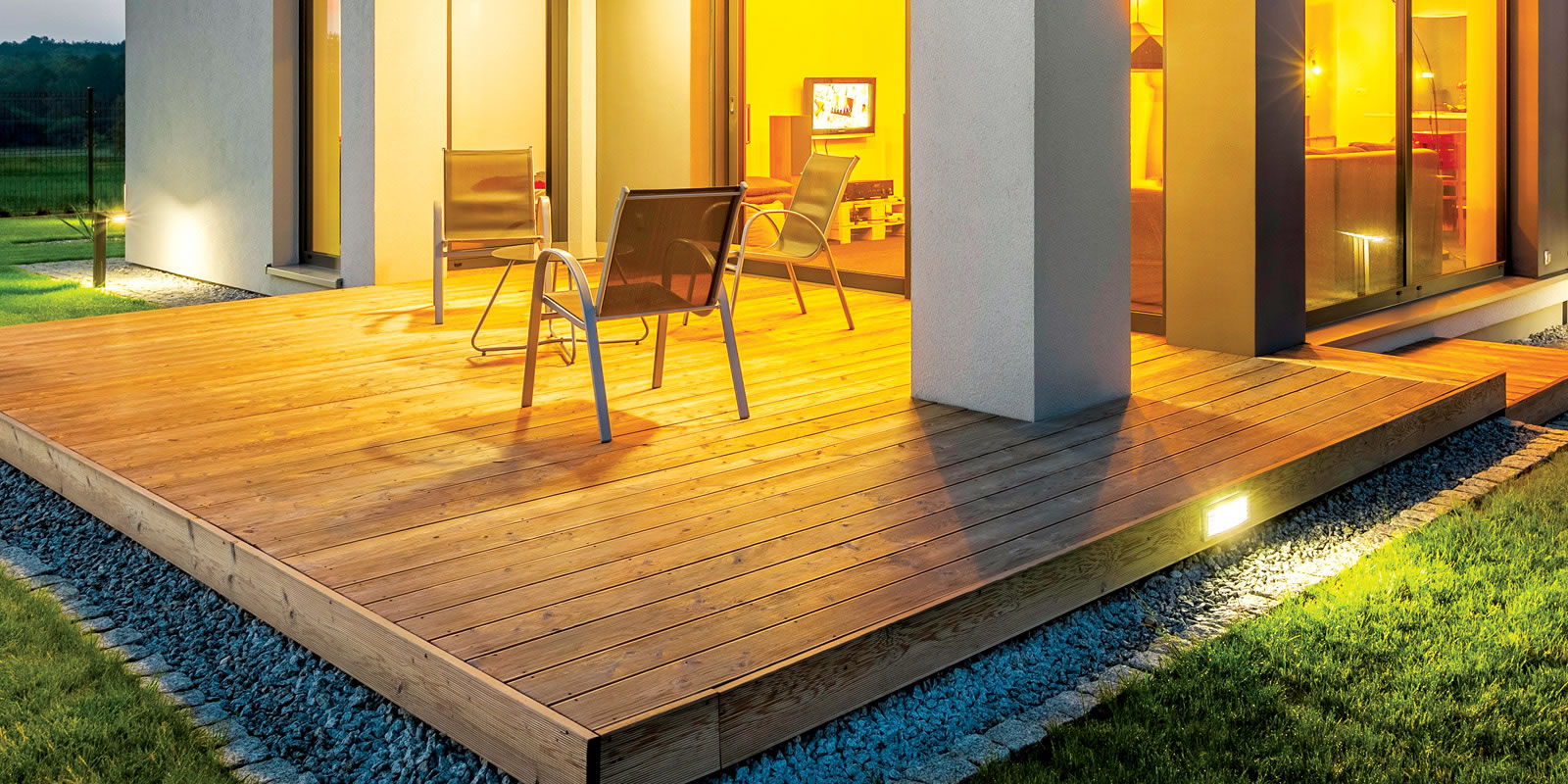
ไม้ชนิดใดเหมาะที่สุดสำหรับโครงการทำพื้นระเบียง
คุณตัดสินใจแล้วที่จะใช้ไม้สำหรับพื้นระเบียงของคุณ ตอนนี้ถึงเวลาที่จะต้องตัดสินใจว่าไม้ชนิดใดเหมาะสมที่สุดสำหรับโครงการของคุณ
ปัจจัยที่ต้องพิจารณาในการเลือกชนิดของไม้ ได้แก่ ความสวยงาม สถานที่ติดตั้งระเบียง ความต้องการในการบำรุงรักษาอย่างต่อเนื่อง งบประมาณ และความพร้อมในการหาซื้อไม้
ความสวยงาม
ไม้มักถูกเลือกเพราะความสวยงามตามธรรมชาติและรูปลักษณ์ที่น่าดึงดูด การโชว์ลายไม้สามารถให้ผลกระทบที่น่าทึ่งและสวยงาม
เมื่อเลือกชนิดของไม้ พิจารณาสีที่คุณต้องการสำหรับพื้นระเบียง การเสริมโทนสีธรรมชาติของไม้สามารถทำได้ด้วยการใช้ Colourtone โดยการเลือกเฉดสีที่เข้ากับสีธรรมชาติของไม้ ลายไม้และตาไม้จะโดดเด่นขึ้น การเพิ่มสีจะช่วยสร้างลุคที่มีสไตล์
สถานที่
การเลือกไม้ที่สามารถทนต่อสภาพอากาศที่มันจะสัมผัสได้นั้นเป็นสิ่งสำคัญ
การสัมผัสที่มากเกินไปกับฝน แดด และแม้แต่ลม จะต้องใช้ไม้ที่ทนทาน การใช้ ระบบการปกป้องไม้ของ CUTEK® จะช่วยป้องกันสภาพอากาศและมั่นใจได้ว่าพื้นระเบียงจะยังคงดูดีไปอีกหลายปี
การบำรุงรักษาอย่างต่อเนื่อง
ไม่ว่าจะเลือกใช้วัสดุใด ระเบียงของคุณจะต้องการการบำรุงรักษาอย่างสม่ำเสมอเพื่อให้ยังคงดูดี ควรจำไว้ว่าไม้บางชนิดทำพื้นระเบียงจะดูแลรักษาได้ง่ายและรวดเร็วกว่าชนิดอื่น
การใช้น้ำมันรักษาเนื้อไม้ CUTEK® จะช่วยได้ ในสภาพอากาศรุนแรงให้เลือกใช้ CUTEK® Extreme CD50 ซึ่งถูกพัฒนามาเพื่อรับมือสำหรับสภาพอากาศประเภทนี้โดยเฉพาะ
งบประมาณและความพร้อมในการหาซื้อ
ไม้สำหรับทำพื้นระเบียงมีราคาต่างกันไป ตั้งแต่ไม้เนื้อแข็งที่มีราคาแพง ไปจนถึงไม้สนที่ผ่านการอบน้ำยาราคาไม่สูง
หากคุณมีงบประมาณจำกัด ให้วางแผนพื้นที่ที่จะต้องครอบคลุม และคำนึงถึงคุณสมบัติที่คุณต้องการให้เหมาะกับวัตถุประสงค์ในการใช้งานของพื้นระเบียง ไม้ที่หาง่ายมักจะมีราคาถูกกว่าและหาซื้อได้ง่ายกว่า โดยเฉพาะหากคุณมีเวลาจำกัดในการดำเนินโครงการ
ไม้เนื้อแข็ง
มีไม้เนื้อแข็งหลายชนิดให้เลือกที่เหมาะสำหรับโครงการทำพื้นระเบียง
ข้อดีของไม้เนื้อแข็ง
- สามารถสร้างผลงานที่โดดเด่น
- ไม้คุณภาพสูง ทนทาน
- มักมีราคาถูกกว่าการทำพื้นร
ข้อเสียของไม้เนื้อแข็ง
- บางชนิดมีแนวโน้มที่จะแตกออกหรือเกิดรอยสนิมจากเหล็ก
- อาจมีราคาสูงกว่าการทำพื้นระเบียงจากไม้สนที่ผ่านการอบน้ำยา
- อาจเจาะหรือยึดน็อตได้ยาก
สายพันธุ์ของไม้เนื้อแข็ง
มีไม้เนื้อแข็งหลายชนิดให้เลือกไม้หลุมพอ Merbau มีโทนสีแดงน้ำตาลอบอุ่น ซึ่งสร้างพื้นระเบียงที่โดดเด่นและสามารถใช้งานได้ตลอดปี ชนิดนี้ทนทาน ราคาอาจต่ำกว่าสำหรับไม้เนื้อแข็งชนิดอื่น
ไม้แดงและไม้เต็งเป็นไม้เนื้อแข็งที่ทนทานที่สุดสำหรับพื้นระเบียงและให้ความทนทานในระยะยาว ทนต่อการผุพังอย่างมาก แต่ข้อเสียคือมีความหนาแน่นสูง ทำให้ทำงานได้ยาก ด้วยความแข็งแรงจึงเป็นตัวเลือกที่ควรพิจารณาสำหรับการติดตั้งที่มีการใช้งานแออัดต่อเนื่อง หรือสำหรับพื้นระเบียงข้างสระน้ำ
ไม้เก่าที่ซื้อจากร้านขายไม้เก่าหรือรื้อมาจากบ้านเก่าชนิดนี้จะมีอัตราการยืดหดน้อย หากอยู่ในสภาพดีมักมีการซึมผ่านของน้ำยาน้อย แต่หากเคยตากแดด/ฝนมาจนซีดเทาจะดูดน้ำยาค่อนข้างมากแม้ว่าจะปรับไสไม้ใหม่แล้วก็ตาม
สายพันธุ์ของไม้เนื้ออ่อน
ไม้สนเรดิอาร์ต้าที่ผ่านการอบน้ำยาได้มาตราฐานมาจากต่างประเทศก็เป็นที่นิยมสำหรับพื้นระเบียงเนื่องจากทนทาน ปลวกไม่กิน ไม่ผุในระยะหนึ่ง ไม้ชนิดนี้ถูกจัดการอย่างยั่งยืนในหลายประเทศ ทำให้เป็นตัวเลือกที่เป็นมิตรกับสิ่งแวดล้อม
การใช้น้ำมันรักษาเนื้อไม้ป้องกันประสิทธิภาพสูง เช่น CUTEK® Extreme CD50 จะช่วยให้พื้นระเบียงไม้เนื้อแข็งของคุณทนต่อสภาพอากาศที่รุนแรงและยังคงสวยงามตลอดทั้งปี
CUTEK® Restore เป็นผลิตภัณฑ์ฟื้นฟูเนื้อไม้เกรดมืออาชีพที่ช่วยเตรียมไม้ให้พร้อมสำหรับน้ำมันรักษาเนื้อไม้
ปัจจัยสำคัญในการเลือกชนิดของไม้ ได้แก่ ความสวยงามที่ต้องการ สถานที่ติดตั้ง การบำรุงรักษาอย่างต่อเนื่อง และงบประมาณ การพิจารณาแต่ละปัจจัยเหล่านี้อย่างรอบคอบจะช่วยให้คุณตัดสินใจเลือกไม้ที่เหมาะสมกับโครงการของคุณได้ดีที่สุด
